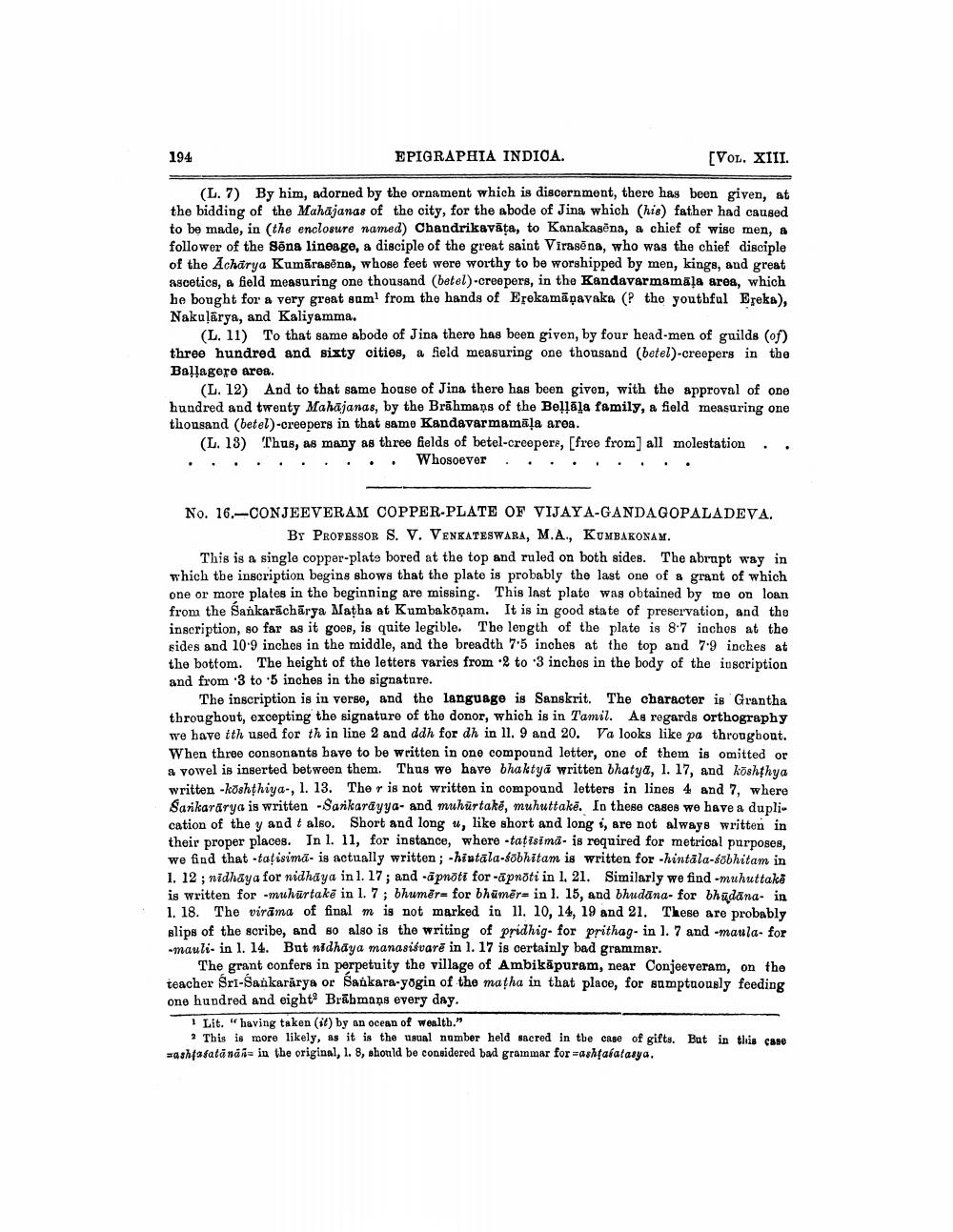________________
EPIGRAPHIA INDICA.
[VOL. XIII.
(L. 7) By him, adorned by the ornament which is discernment, there has been given, at the bidding of the Mahajanas of the city, for the abode of Jina which (his) father had caused to be made, in (the enclosure named) Chandrikavāṭa, to Kanakasēna, a chief of wise men, a follower of the Sena lineage, a disciple of the great saint Virasēna, who was the chief disciple of the Acharya Kumarasēna, whose feet were worthy to be worshipped by men, kings, and great ascetics, a field measuring one thousand (betel)-creepers, in the Kandavarmamala area, which he bought for a very great sum1 from the hands of Erekamā pavaka (? the youthful Ereka), Nakularya, and Kaliyamma.
(L. 11) To that same abode of Jina there has been given, by four head-men of guilds (of) three hundred and sixty cities, a field measuring one thousand (betel)-creepers in the Ballagere area.
(L. 12) And to that same house of Jina there has been given, with the approval of one hundred and twenty Mahajanas, by the Brahmans of the Bellala family, a field measuring one thousand (betel)-creepers in that same Kandavarmamāļa area.
(L. 13) Thus, as many as three fields of betel-creepers, [free from] all molestation. Whosoever
194
No. 16.-CONJEEVERAM COPPER-PLATE OF VIJAYA-GANDAGOPALADEVA. BY PROFESSOR S. V. VENKATESWARA, M.A., KUMBAKONAM.
This is a single copper-plate bored at the top and ruled on both sides. The abrupt way in which the inscription begins shows that the plate is probably the last one of a grant of which one or more plates in the beginning are missing. This last plate was obtained by me on loan from the Sankaracharya Matha at Kumbakonam. It is in good state of preservation, and the inscription, so far as it goes, is quite legible. The length of the plate is 87 inches at the sides and 10.9 inches in the middle, and the breadth 7.5 inches at the top and 7-9 inches at the bottom. The height of the letters varies from 2 to 3 inches in the body of the inscription and from 3 to 5 inches in the signature.
The inscription is in verse, and the language is Sanskrit. The character is Grantha throughout, excepting the signature of the donor, which is in Tamil. As regards orthography we have ith used for th in line 2 and ddh for dh in 11. 9 and 20. Va looks like pa throughout. When three consonants have to be written in one compound letter, one of them is omitted or a vowel is inserted between them. Thus we have bhaktyä written bhatya, 1. 17, and kōshthya written -koshṭhiya-, 1. 13. The r is not written in compound letters in lines 4 and 7, where Sankararya is written -Sankarayya- and muhūrtaké, muhuttakē. In these cases we have a duplication of the y and t also. Short and long u, like short and long i, are not always written in their proper places. In 1. 11, for instance, where -taṭisima- is required for metrical purposes, we find that -tatisima- is actually written; -hintala-sobhitam is written for -hintala-sobhitam in 1. 12; nidhaya for nidhaya in 1. 17; and -āpnoti for -apnoti in 1. 21. Similarly we find -muhuttake is written for -muhurtake in 1. 7; bhumer for bhümer in 1. 15, and bhudana- for bhudana- in 1. 18. The virama of final m is not marked in 11. 10, 14, 19 and 21. These are probably slips of the scribe, and so also is the writing of pridhig- for prithag- in 1. 7 and -maula- for -mauli- in 1. 14. But nidhaya manasisvare in 1. 17 is certainly bad grammar.
The grant confers in perpetuity the village of Ambikapuram, near Conjeeveram, on the teacher Sri-Sankararya or Sankara-yogin of the matha in that place, for sumptuously feeding one hundred and eight Brahmans every day.
1 Lit. "having taken (it) by an ocean of wealth."
2 This is more likely, as it is the usual number held sacred in the case of gifts. But in this case. =ashtasatānāñ= in the original, 1. 8, should be considered bad grammar for =ashtalatasya.




